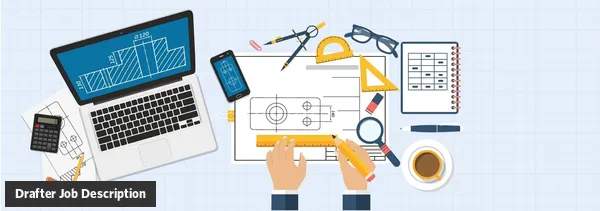Drafter Job Description Template
Use this Drafter job description template to advertise the open roles for free using Longlist.io. You can use this template as a starting point, modify the requirements according the needs of your organization or the client you are hiring for.

Job Brief
We are looking for a Drafter to work with our team of Architects and Engineers and convert designs into technical plans.
Drafter responsibilities include gathering drawings and specifications, calculating material and equipment requirements and setting up production methods. If you have hands-on experience with computer-aided design (CAD) software and are familiar with building processes, we’d like to meet you.
Ultimately, you’ll help us build functional, secure and well-designed products and structures that meet our needs.
Responsibilities
- Liaise with architects and engineers to gather product and structural requirements and designs
- Calculate dimensions, weight limitations and requirements in materials
- Describe production methods step-by-step (including equipment and software types to be used)
- Create detailed designs with computer-aided design (CAD) software
- Design diagrams, maps and layouts to illustrate workflow
- Prepare and review rough sketches and review them along with the engineering team
- Identify potential operational issues and redesign products to improve functionality
- Ensure final designs comply with regulations and quality standards
- Create manuals that describe existing products’ operation, features and maintenance
Requirements
- Proven work experience as a Drafter or similar role
- Hands-on experience with computer-aided design (CAD) software
- Familiarity with 3D modeling tools
- Good math skills
- Ability to meet deadlines
- BSc in Engineering, Architecture or degree from a technical college
- Additional certification from the American Design Drafting Association (ADDA) is a plus
What does Drafter do?
A drafter, also known as a draftsperson, creates technical drawings and plans for architects, engineers, and other professionals involved in the design and construction process. On a day-to-day basis, a drafter can perform the following tasks:
-
Review and understand project requirements: The drafter starts by reviewing project specifications, sketches, and notes provided by architects or engineers.
-
Create initial drafts: Using computer-aided design (CAD) software, the drafter creates the initial draft of the design or plans. This may include creating 2D or 3D models, layouts, and drawings.
-
Collaborate with design team: The drafter works closely with architects, engineers, and other stakeholders to ensure the drawings meet the project requirements and make any necessary revisions or adjustments.
-
Incorporate design changes: As the project progresses, the drafter incorporates any design changes or modifications into the technical drawings, ensuring that all revised details are accurately reflected.
-
Produce detailed drawings: Once the design is approved, the drafter produces a comprehensive set of detailed drawings that illustrate the various aspects of the plan. This includes dimensions, materials, and other specifications required for construction.
-
Review and check drawings: Before finalizing the drawings, the drafter carefully reviews and checks for accuracy, completeness, and compliance with relevant codes and standards.
-
Coordinate with contractors and suppliers: The drafter may work closely with contractors and suppliers to ensure they have all the necessary information from the drawings to proceed with the construction process.
-
Document and maintain records: The drafter keeps records of all drawings, revisions, and design changes made during the project. This ensures that accurate information is available for future reference or project maintenance.
-
Stay updated on industry standards: Drafters continuously update their knowledge of new technologies, software updates, and industry standards to improve their drafting skills and stay relevant in the profession.
The specific duties of a drafter can vary depending on the industry they work in (e.g., architectural drafting, electrical drafting, mechanical drafting) and the scale and complexity of the projects they are involved in.
